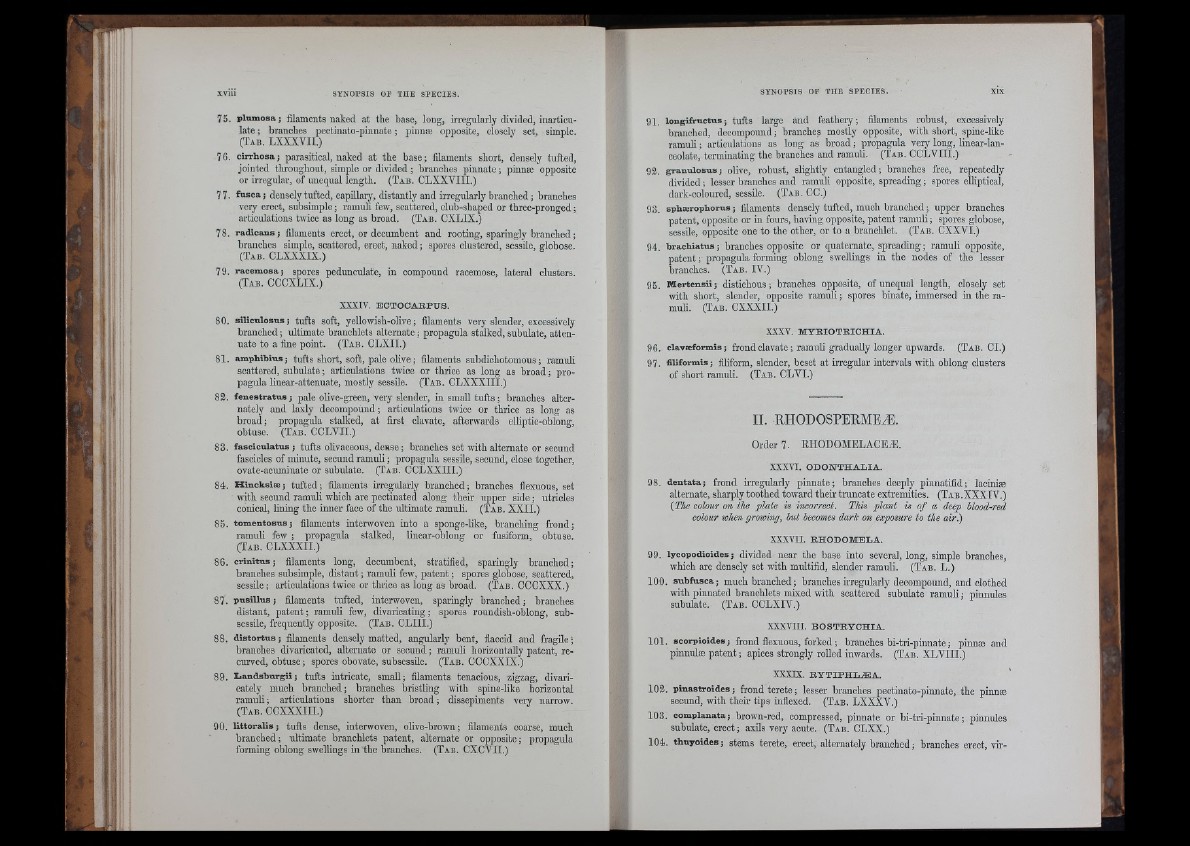
7 5. plumosa ; filaments naked at the base, long, irregularly divided, inarticulate
; branches pectinato-pinnate ; pinnæ opposite, closely set, simple.
(Tab. LXXXVII.)
76. cirrhosa; parasitical, naked at the base; filaments short, densely tufted,
jointed throughout, simple or divided ; branches pinnate; pinnæ opposite
or irregular, of unequal length. (T a b . CLXXVIII.)
77. fusca; densely tufted, capiUary, distantly and irregularly branched; branches
very erect, subsimple ; ramuli few, scattered, club-shaped or three-pronged ;
articulations twice as long as broad. (T ab . CXLIX.)
78. radicansj filaments erect, or decumbent and rooting, sparingly branched ;
branches simple, scattered, erect, naked; spores clustered, sessile, globose.
(T ab . CLXXXIX.)
79. racemosa; spores pedunculate, in compound racemose, lateral clusters.
(T ab. CCCXLIX.)
XXXIV. ECTOCABPUS.
80. siliculosus; tufts soft, yellowish-olive; filaments very slender, excessively
branched ; ultimate brauchlets alternate ; propagula stalked, subulate, attenuate
to a fine point. (T ab . CLXII.)
81. amphibius; tufts short, soft, pale olive; filaments subdichotomous; ramuli
scattered, subulate; articulations twice or thrice as long as broad; propagula
linear-attenuate, mostly sessile. (T ab. CLXXXIII.)
83. fenestratus ; pale oUve-green, very slender, in small tufts ; branches alternately
and laxly decompound; airiculations twice or thrice as long as
broad; propagula stalked, at first clavate, afterwards elliptic-oblong,
obtuse. (T ab . CCLVII.)
83. fasciculatns ; tufts olivaceous, d e s s e ; branches set with alternate or secund
fascicles of minute, secund ramuli ; propagula sessile, secund, close together,
ovate-acuminate or subulate. (T ab . CCLXXIII.)
84. Hincksiæ ; tufted ; filaments irregularly branched ; branches flexuous, set
with secund ramuli which are pectinated along their upper side ; utricles
conical, lining the inner face of the ultimate ramuli. (Tab. XXII.)
85. tomentospsJ filaments interwoven into a sponge-like, branching frond;
ramuli few ; propagula stalked, linear-oblong or fusiform, obtuse.
(Tab. CLXXXII.)
86. c rin itu s ; filaments long, decumbent, stratified, sparingly branched;
branches subsimple, distant ; ramuli few, patent ; spores globose, scattered,
sessile ; articulations twice or thrice as long as broad. (T ab. CCCXXX.)
87. pu sillu s; filaments tufted, interwoven, sparingly b ranched; branches
distant, p a te n t; ramuli few, divaricating; spores roundish-oblong, sub-
sessüe, frequently opposite. (Tab. CLIII.)
88. d isto rtu s; filaments densely matted, angularly bent, flaccid and fragile ;
branches divaricated, alternate or secund ; ramuli horizontally patent, re-
cm-ved, obtuse ; spores obovate, subsessile. (T ab . CCCXXIX.)
89. L audsburgii; tufts intricate, small; filaments tenacious, zigzag, divaii-
cately much branched; branches bristling with spine-like horizontal
ramuli ; articulations shorter than broad ; dissepiments very narrow.
(T ab . CCXXXIII.)
90. Uttoralis; tufts dense, interwoven, olive-brown; filaments coarse, much
branched; ultimate brauchlets patent, alternate or opposite; propagula
forming oblong swellings in the branches. (T ab . CXCVII.)
91. l o n g i f r u e tu s ; tufts large and feathery; filaments robust, excessively
branched, decompound; branches mostly opposite, rvitli short, spine-like
ramuli; articulations as long as broad; propagula very long, linear-lanceolate,
terminating the branches and ramuli. (T ab . CCLVIII.)
93. g r a u u lo s u s ; olive, robust, slightly entangled; branches free, repeatedly
divided; lesser branches and ramuli opposite, spreading; spores elliptical,
dark-coloured, sessile. (T ab . CC.)
93. s p h s e ro p k o ru s ; filaments densely tufted, much branched; upper branches
patent, opposite or in fours, having opposite, patent ramuli; spores globose,
sessüe, opposite one to the other, or to a branchlet. (Tab. CXXVI.)
94. b r a c h i a tu s ; branches opposite or quaternate, spreading; ramuli opposite,
patent; propagula forming oblong swellings in the nodes of the lesser
branches. (T ab . IV.)
95. MertcnsU; distichous; branches opposite, of unequal length, closely set
with short, slender, opposite ramuli; spores binate, immersed in the ramuli.
(T ab. CXXXII.)
XXXV. M YEIOTEICHIA.
96. c la v s e fo rm is ; frond clavate; ramuli gradually longer upwards. (T ab . CI.)
97. fiU fo rm is; fiUform, slender, beset at irregular intervals with oblong clusters
of short ramuli. (T ab . CLVI.)
II. RHODOSPERMEÆ.
Order 7. EHODOMELACEÆ.
XXXVI. ODONTHALIA.
98. d e n t a t a ; frond irregularly pinnate; branches deeply piiinatifid; laciniæ
alternate, sharply toothed toward their truncate extremities. (T a b .X X X IV .)
(The colour on the plate is incorrect. This plant is o f a deep hlood-red
colour when growing, hut becomes dark on exposure to the air)
XXXVII. EHODOMBLA.
99. ly c o p o d io id e s ; divided near the base into several, long, simple branches,
which are densely set with multifid, slender ramuli. (T ab . L .)
100. s u b f iis c a ; much branched ; branches frregularly decompound, and clothed
with pinnated brauchlets mixed with scattered subulate ramuli ; pinnules
subulate. (T a b . C C L X IV .)
XXXVIII. BOSTEYOHIA.
101. s c o r p io id e s ; frond flexuous, forked ; branches bi-tri-pinnate ; pinnæ and
pinnulæ patent ; apices strongly rolled inwards. (Tab. XLVIII.)
XXXIX. EY T IPH LÆ A .
102. p in a s t r o id e s ; frond terete ; lesser branches pectinato-pinnate, the pinnæ
secund, with their tips inflexed. (T ab . LXXXV.)
103. c om p la n a ta ; brown-red, compressed, pinnate or bi-tri-pinnate; pinnules
subulate, erect; axils very acute. (T ab . CLXX.)
104. th u y o id e s ; stems terete, erect, alternately branched ; branches erect, vir